The European Avant-Gardes, 1905-1935
A Portable Guide
Format:Paperback
Publisher:Edinburgh University Press
Published:6th Sep '18
Should be back in stock very soon

Introduces the full range and depth of the early 20th-century European avant-gardes This engaging introduction outlines the cultural and political contexts in which the avant-gardes operated, taking readers on a journey throughout the whole of Europe. It discusses the most salient features of the avant-gardes’ work in all the arts, succinctly surveys the major avant-garde movements (cubism, futurism, expressionism, Dadaism, constructivism and many other –isms) and demonstrates the ways in which they transformed the face of all modern art forms. Clearly written, this book shows readers and students of modernism how and why the avant-gardes were a major force in modern art and culture. Key Features An up-to-date and thorough guide to the ‘classic’ European avant-gardes, from 1905 to 1935Covers all the arts practiced by the classic European avant-gardes – from painting and film, literature and sculpture, architecture and photography to theatre, dance and music – focusing on the specificity of each art form as well as on what united them Includes text-boxes, 100 illustrations, many in colour, and a user-friendly index/glossary
An impressive tour de force which will be welcomed by everyone with an interest in the history of the avant-garde. This book will serve both as introductory survey and an extremely useful tool for teaching. But it is so much more than that. What sets this book apart are perhaps three things: the author is intimately familiar with sources in different languages and cultures; he wears his knowledge and scholarship lightly; and he allows his subject – the European avant-gardes – to dictate the methods and approaches, so that this book genuinely embodies a rigorous, and far from capricious, pluralism. -- Andreas Kramer, Goldsmiths, University of London * Arcadia *
The publisher calls it an "introduction" to the works, the authors, the currents, and the contexts of the European avant-gardes in the period 1905-1935. But this is really not the best word to qualify the "portable guide" proposed by one of the leading voices in the field. This book is not just a suitcase that one opens to find answers to specific queries (the very detailed index will prove very useful in this regard), it is also a door that one can open to discover new or never thought-of questions, less known or never disclosed examples (and here the exceptional iconography is vital), and simply enjoy the writing, a perfect mix of intellectual sympathy and critical distance. -- Jan Baetens, University of Leuven * Cultural Studies Leuven *
This book has every prospect of becoming the founding and defining pedagogic platform for avant-garde studies. * Jed Rasula, University of Georgia *
With the most impressive yet lightly-worn erudition (…) it is, above all, an extremely carefully-structured book. It’s everything a guidebook should be: informative, enjoyable, lively, a good companion, reliable and, indeed, portable; in short, well worth a detour to buy a copy. -- David Cottington, Kingston University London * Konsthistorisk Tidskrift/Journal of Art History *
This "portable guide" — succinct but never superficial, precise but never pedantic, may well be the one indispensable book on the European Avant-Garde movements. Bru’s concluding speculations on the future of the avant-garde and its various theorists is especially welcome. A brilliant study! * Marjorie Perloff, Stanford University *
A new, very promising and appropriate approach to the subject. * Natalie Adamson, Reader in Art History, University of St Andrews *
By paying attention to the political dimension of the avant-garde, this book yields a multifaceted image and by foregrounding the role of women in the patriarchal avant-garde it sketches a more ambivalent picture than that encountered in research so far. (…) With its interdisciplinary approach it allows to draw interesting parallels. -- Janka Wagner, University of Oldenburg * Spiegel der Letteren *
Sascha Bru’s The European Avant-Gardes, 1905-1935: A Portable Guide offers a highly readable, consistently informative, and, it should be said, unerringly successful description of the rise to prominence (if that is the right word) of an ersatz group of artists and writers who set out to either make sense of, or fundamentally critique, a Europe that was undergoing considerable historical, cultural, geographical, economic, and, perhaps above all, political transformation in the early decades of the twentieth century. Scholars who are relatively early on in their engagement with the avant-gardes could not ask for a better place to start their research, and those who have been working in and around this field for many years will find much that is new, edifying, and energising in Bru’s eclectic and expansive approach. I cannot imagine a reader of this book who will not learn a considerable amount about the field under consideration, and I cannot imagine a writer better than Bru, whose career to date has been steeped in a critical exposition of the avant-garde, to guide us through this tangled, multi-media, vaguely networked and always arresting field of inquiry. -- Robert Brazeau, University of Alberta * The Modernist Review *
ISBN: 9780748695911
Dimensions: unknown
Weight: 544g
280 pages